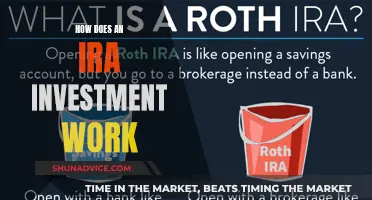
A retirement investment profile is a collection of assets that are expected to grow in value over time, providing income during retirement. This includes stocks, bonds, funds, annuities, and real property. The goal is to build a portfolio that meets an individual's financial goals and needs during retirement, taking into account factors such as risk tolerance, investment objectives, and time horizon. While stocks are a core asset due to their long-term appreciation potential, other types of investments such as bonds and funds also play a role in diversifying and stabilising the portfolio.
| Characteristics | Values |
|---|---|
| Purpose | To provide income during retirement |
| Composition | Stocks, bonds, funds, annuities, real property |
| Management | Active, passive, discretionary, non-discretionary |
| Time Horizon | Long-term (20+ years) |
| Risk Tolerance | Dependent on age and comfort with volatility |
| Tax Treatment | Taxable, tax-deferred, tax-free |
What You'll Learn

Stocks, bonds and funds as the most common investment types
When it comes to retirement planning, investing is a crucial aspect. A retirement investment profile typically includes a range of investment types, with the most common ones being stocks, bonds, and funds. These investment options offer individuals avenues to grow their wealth and secure their financial future. Here's a detailed look at each of these common investment types:
Stocks
Stocks, also known as shares or equities, are one of the most well-known and straightforward investment types. When you buy a stock, you purchase a small ownership stake in a publicly traded company. The value of your stock fluctuates based on the company's financial performance and market conditions. Stocks are considered high-risk, high-reward investments, as there is no guarantee of value increase, but they have the potential for substantial returns. Stocks are an excellent way to diversify your investment portfolio and are often recommended by investment specialists.
Bonds
Bonds are fixed-income or debt investments. When you purchase a bond, you essentially loan money to a company or government entity. Bonds are issued by companies, local governments, or the U.S. Treasury, and they come in various forms, including corporate and municipal bonds. The issuer of the bond agrees to pay the investor interest over a specified time frame, and at the end of the period, the full amount borrowed, known as the principal, is repaid. Bonds typically offer lower returns than stocks but are considered lower risk. However, there is still a risk of default, where the issuer may fail to repay the principal.
Mutual Funds
Mutual funds are investment vehicles where money from multiple investors is pooled together and invested in a diversified portfolio of securities, such as stocks, bonds, commodities, currencies, and derivatives. These funds are managed by professionals who actively monitor and adjust the portfolio to maximise returns. Mutual funds offer investors the advantage of diversification and professional management. They usually have a minimum investment requirement and charge an annual fee. While mutual funds carry similar risks to stocks and bonds, the inherent diversification often results in lower risk.
Exchange-Traded Funds (ETFs)
ETFs (Exchange-Traded Funds) are similar to mutual funds in that they are also baskets of various securities, including stocks, bonds, commodities, and other assets. However, ETFs are traded on stock exchanges, and their prices fluctuate throughout the trading day. ETFs can be passively managed, tracking a market index, or actively managed, aiming to achieve a specific investment strategy. They are a popular investment choice due to their potential diversification benefits, low costs, and potential tax advantages.
In conclusion, stocks, bonds, mutual funds, and ETFs are some of the most common investment types that individuals use to build their retirement investment profiles. Each investment type has its own characteristics, risks, and potential rewards. It's important to carefully consider these factors and seek professional advice when crafting a retirement investment strategy to ensure it aligns with your financial goals, risk tolerance, and time horizon.
Volatility: Friend or Foe?
You may want to see also

Tax-deferred accounts and their benefits
Tax-deferred accounts are a form of tax-advantaged investment portfolio designed to help individuals save for retirement. They are one of the most common forms of retirement accounts. The most popular tax-deferred retirement accounts include 401(k)s and traditional individual retirement accounts (IRAs).
Benefits of Tax-Deferred Accounts
Lower Taxable Income
Contributions to tax-deferred accounts are typically made from pre-tax income, reducing your taxable income for that year. This lowers the federal taxes owed by the individual for that year.
Tax-Free Growth
The money in the account grows tax-free until it is withdrawn. You won't be taxed on dividends, interest, or capital gains until you take out money from the account.
Potential Employer Match
Many employers will match some or all of your contributions to your 401(k) plan, adding up over the years.
Lower Taxes in Retirement
Many people expect to earn less in retirement than during their working years, which may result in a lower tax bracket. In that case, you could wind up paying less in taxes over time since your withdrawals in retirement would be taxed at a lower rate.
No Taxes on Investment Gains
Within a tax-deferred account, you can buy and sell assets without triggering any tax. You can make investment moves without worrying about the effect of a sale on your current tax situation as long as the money stays in the account.
Encourages Savings Discipline
Withdrawing money from a tax-deferred account before the age of 59 1/2 usually comes with a 10% early withdrawal penalty. This helps to prevent individuals from tapping into their retirement savings early.
Sports Fandom: Why the Obsession?
You may want to see also

Active vs. Passive investing
Active and passive investing are two contrasting strategies for investing money. Both measure their success against benchmarks like the S&P 500, but active investing generally aims to beat the benchmark, whereas passive investing seeks to match its performance.
Active Investing
Active investors buy stocks or other investments regularly and sell those that are not performing well. This strategy requires a hands-on approach and a high level of market analysis and expertise. Active investors need to be able to determine the best time to buy or sell investments. This can be done by the investor themselves, or through actively managed mutual funds and active exchange-traded funds (ETFs). Active fund managers assess a wide range of data about every investment in their portfolios and use that information to buy and sell assets to take advantage of short-term price fluctuations and keep the fund’s asset allocation on track.
Advantages of Active Investing
- Flexibility in volatile markets: Active investors can move to defensive holdings during down markets to prevent losses, or reallocate to hold more equities in growing markets.
- Expanded trading options: Active investors can use strategies such as hedging with options or shorting stock to produce windfalls that increase the odds they beat market indexes.
- Tax management: A savvy financial advisor can use active investing to execute trades that offset gains for tax purposes (tax-loss harvesting).
Disadvantages of Active Investing
- Higher fees: Active funds have relatively high expense ratios, averaging 0.68-0.71% in 2020.
- Increased risk: When active investors are wrong, they can face catastrophic losses, especially if they used borrowed money (margin) to invest.
- Trend exposure: It's easy for active investors to follow trends, but difficult to know if there's still room for growth.
Passive Investing
Passive investors rarely buy individual investments, instead holding investments over a long period or purchasing shares of a mutual or exchange-traded fund. Passive investing is a hands-off approach, requiring investors to choose a security and hold on to it through ups and downs with a long-range goal in mind, such as retirement. Passive investors don't try to profit from short-term price fluctuations or market timing.
Advantages of Passive Investing
- Lower costs: Passive investing is associated with reduced trading volumes and fewer transactions, leading to lower costs for individual investors.
- Decreased risk: Passive strategies tend to be more fund-focused, meaning investors are typically investing in hundreds or thousands of stocks and bonds, providing easy diversification.
- Increased transparency: It's always clear which assets are in a passive fund.
- Higher average returns: Passive funds of all kinds tend to give higher returns over the long term.
Disadvantages of Passive Investing
- Not flashy: Passive investing doesn't offer the excitement of seeing quick, skyrocketing returns from a single stock.
- No exit strategy in severe bear markets: Passive investing doesn't allow investors to pull out during severe market downturns.
Active vs. Passive: Which is Better?
Passive investing tends to perform better and is also cheaper, but active investing can be useful for certain types of investors. For example, an active strategy might suit someone close to retirement who doesn't have time to recover from large losses.
Many investment advisors believe the best strategy is a blend of both active and passive styles, which can help minimize the wild swings in stock prices during volatile periods.
Mortgage Lenders: Your Investment Papers, Please!
You may want to see also

Time horizon and portfolio allocation
When it comes to retirement planning, time horizon and portfolio allocation are crucial. The time horizon refers to the expected duration of an investment, which can be short-term, medium-term, or long-term. This duration is influenced by factors such as age, investment goals, and current regulations. For retirement planning, the time horizon is typically long-term, spanning several decades.
Portfolio allocation, or asset allocation, is the diversification of investments across stocks, bonds, and cash. The allocation should be aligned with the time horizon and adjusted as the horizon changes. Here's how time horizon and portfolio allocation work together:
Short-Term Horizon
Short-term investment horizons are those with a duration of fewer than five years. For retirement planning, this may be relevant for individuals approaching retirement age or those who need access to their funds soon. During this period, investments are typically shifted to more conservative options to preserve capital. Money market funds, savings accounts, certificates of deposit, and short-term bonds are common choices as they can be easily converted to cash.
Medium-Term Horizon
Medium-term investment horizons span three to ten years. While this range is not typically associated with retirement planning, it can be relevant for individuals saving for other goals, such as a child's college education. During this period, a balance between high- and low-risk assets is sought, often through a mix of stocks and bonds, to protect wealth while still allowing for growth.
Long-Term Horizon
Long-term investment horizons are those with a duration of ten years or more, often associated with retirement savings. During the early stages of a long-term horizon, investors can be more aggressive due to the longer time frame for recovery from market fluctuations. Stocks become a more attractive option, offering greater potential rewards over time. However, as the time horizon progresses, the allocation should be adjusted to reduce risk.
It is important to note that while time horizon is a critical factor, it should be considered alongside other factors such as risk tolerance, investment goals, and current financial situation. The ideal portfolio allocation will vary from person to person, and it is essential to regularly review and rebalance your allocation to align with your changing circumstances and goals.
Invest in Veneck: The Next Big Thing
You may want to see also

Risk tolerance and its impact on investment choices
Risk tolerance is a crucial aspect of retirement investment planning, influencing the types and amounts of investments individuals choose to make. It refers to the degree of risk an investor is willing to accept, given the potential volatility in the value of their investments. Understanding one's risk tolerance is essential for making informed financial decisions and effectively navigating market fluctuations.
An individual's risk tolerance is shaped by various factors, including their age, investment goals, income, and future earning capacity. Age plays a significant role, as younger investors with a longer time horizon are generally more risk-tolerant and tend to invest in stocks and stock funds. However, it is important to note that age is not the sole determinant, and older individuals with a higher net worth and stable sources of funds can also exhibit higher risk tolerance.
The impact of risk tolerance on investment choices is significant. Individuals with a higher risk tolerance, often referred to as aggressive investors, are willing to risk losing money in pursuit of potentially better returns. Their investment portfolios typically emphasise capital appreciation and include a higher allocation of stocks, with minimal or no allocation to bonds or cash. On the other hand, conservative investors, who have a lower risk tolerance, seek investments with guaranteed returns and low volatility. They tend to favour low-risk options such as bank certificates of deposit, money markets, or US Treasuries.
The time horizon for investments also influences risk tolerance. For long-term financial goals, investors may opt for higher-risk assets, such as stocks, to maximise returns. In contrast, short-term financial goals are more suited to lower-risk cash investments. Additionally, the presence of other assets, such as a home, pension, or inheritance, can affect risk tolerance. Investors with access to stable sources of funds may be more inclined to take on riskier investments.
It is important to note that risk tolerance is not static and can change over time. As individuals approach retirement, their risk tolerance may decrease, leading to a shift in their investment mix towards more stable options. This is a common strategy for retirement savings portfolios, as individuals prioritise stability and confidence in maintaining the value of their portfolio over potential growth.
Understanding one's risk tolerance is essential for making informed investment decisions. Online risk tolerance quizzes and assessments can help individuals determine their risk profile and appropriately diversify their investment portfolios. By aligning their risk tolerance with their investment choices, individuals can ensure that their financial goals and comfort levels are in sync, allowing them to pursue their retirement objectives with confidence.
VOO: Invest Now or Later?
You may want to see also
Frequently asked questions
A retirement investment profile is a collection of assets that are expected to grow in value over time. These assets include stocks, bonds, and funds. The aim is to invest in these securities while you are earning a regular paycheck so that they can be converted into an income when you retire.
A retirement investment profile is necessary unless you already have a large sum of money set aside for your retirement years. Cash savings often do not have the earning power to grow to six figures or more during your lifetime.
The most common investment types for retirement portfolios are stocks, bonds, and funds. Retirement accounts may also support annuities and real property. Stocks are a core asset due to their potential for long-term appreciation and dividend income. Bonds are debt instruments that provide interest income and funds are a budget-friendly way to diversify.







